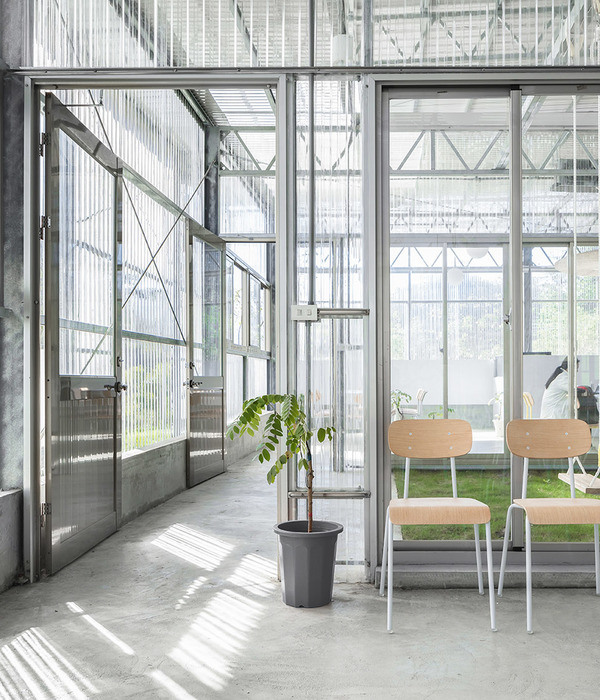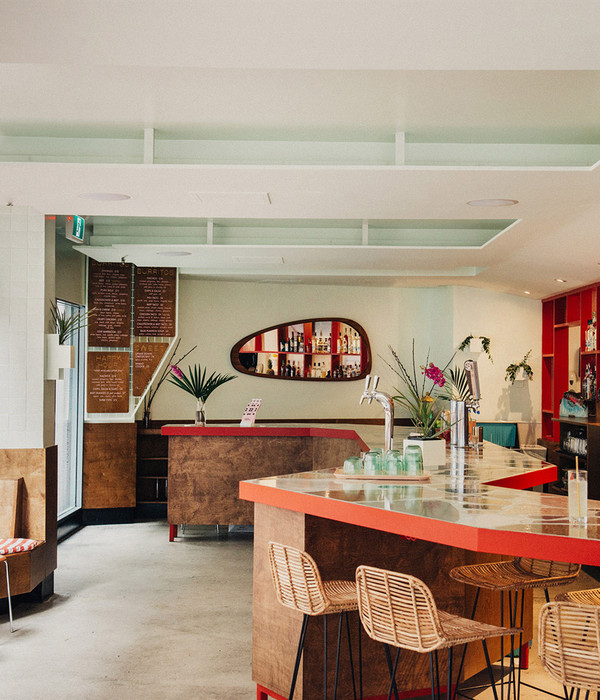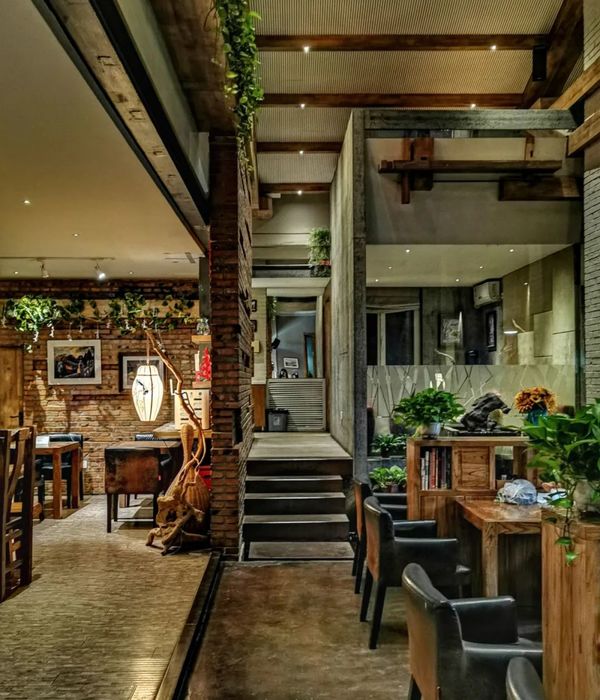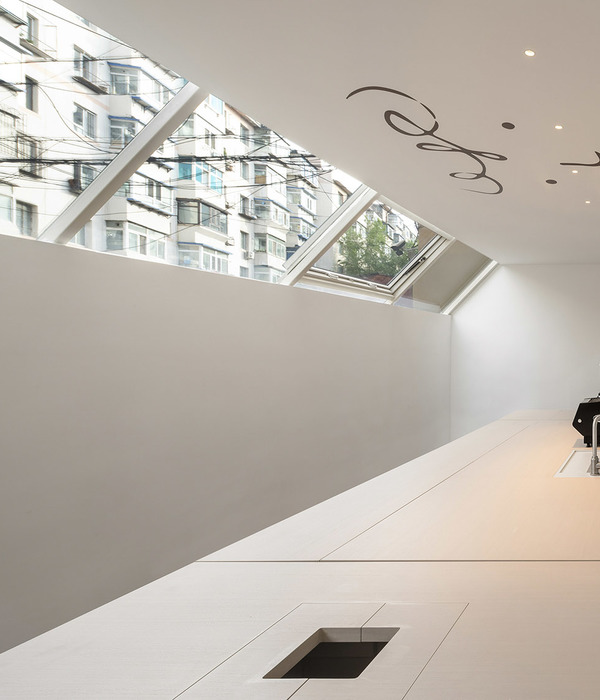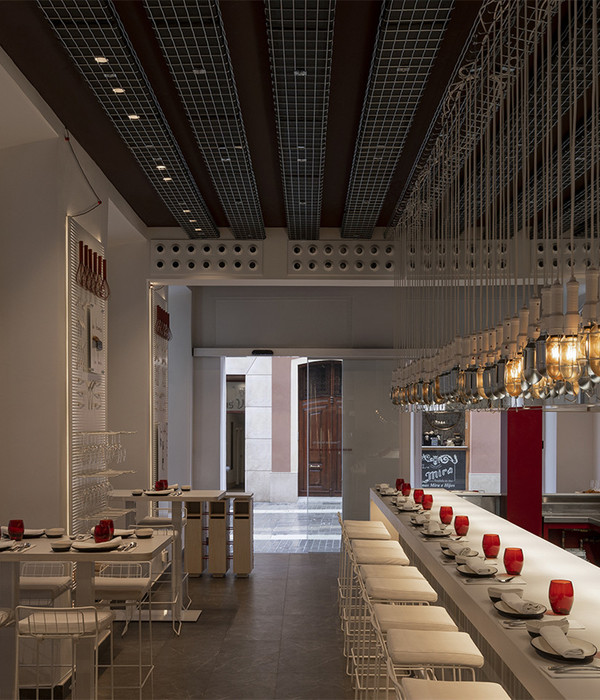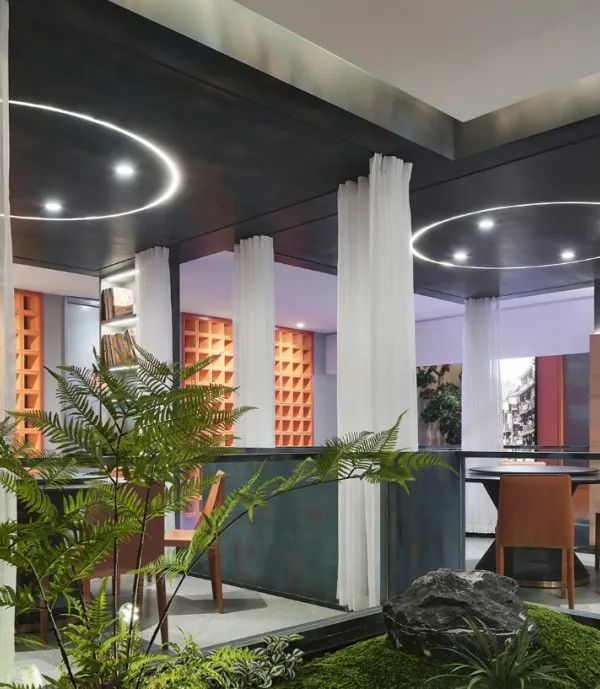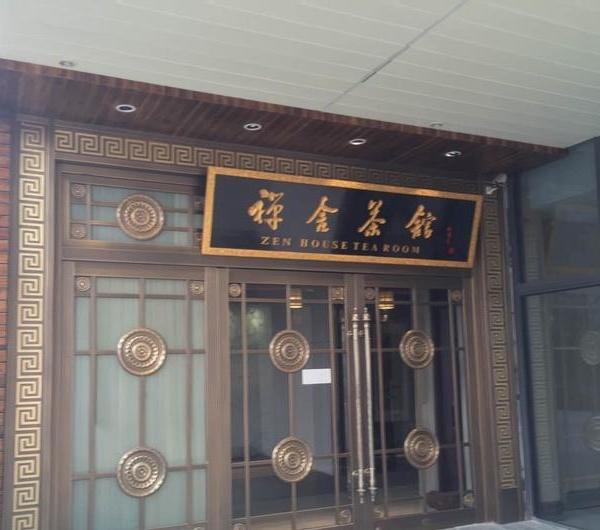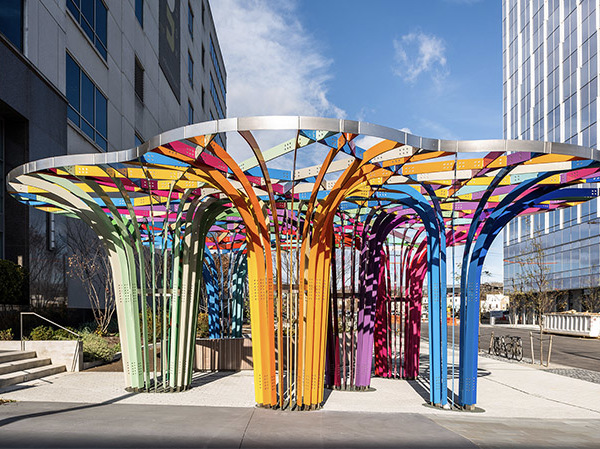- 项目名称:《天堂电影院》 厉槟源个展
- 九层塔:空间与视觉的魔术④
- 策展人:崔灿灿
- 出品人:刘晓都
- 展期:2020年12月26日-
- 展览地点:深圳市坪山美术馆展览馆四层
- 主办:深圳市坪山区文化广电旅游体育局
- 承办:坪山美术馆
- 建筑师:吴林寿
- 设计团队:汤子昱,方晟(实习)
- 平面设计:何见平
- 施工团队:津崐泰文化传媒
- 设计时间:2020年
影像让空间得以多层解读,空间反过来让影像的情感得以延续发酵。也许,每个人心中都住着一个《天堂电影院》里的多多。
—— 吴林寿
Videos offer different possibilities for the interpretation of the space, whereas the space in turn allows the emotions expressed through the videos to be extended and fermented. Perhaps there is a Toto of the Cinema Paradiso in every one’s mind.
—— Linshou WU
以建筑师与艺术家的情感共鸣之处“回不去的故乡”作为出发点,略带乡愁的坡屋顶划分出“二元对立”的不同氛围:内与外,日常与礼仪。这种并置对立,有点拉康精神分析“象征界(Symbolic order)”与“真实界(the Reality)”之间转译的意味,犹如教堂与天堂的并置关系。
Based on the idea of ‘The World You Can Never Go Back’ — the resonance of the architect and the artist, the exhibition creates an environment of binary opposition with a nostalgic slope roof: the internal and external, as well as the routines and etiquettes. The juxtaposition kind of embodies “Symbolic Order” and “the Re-Reality” as described by Jacques Lacan in his psychoanalysis studies, just as the relationship between the church and the paradise.
▼展厅概览,overall of the exhibition hall
屋顶之下,“材料异化”这一动作让空间变得多义。参观者随着影像,例如《钟声》《自由耕种》《海鸟》等呈现而产生情绪变化,抽象空间得以不断隐喻及换喻:聚落、教堂、庭院、堂屋……, 从而承载起个人情感的符号化及象征化。
Under the roof is a space decorated with shoji paper. The space is endowed with diversified meanings through “dematerialization”. Visitors will experience emotional changes with videos such as “The Bell”, “Free Farming”, “Seabirds”, etc. The striking use of metaphor and metonymy in such abstract space as settlements, church, yard and central room carries the symbolization of mixed personal emotions.
▼屋顶之下,overall under the roof
屋顶之外,我们希望能呈现一个浑沌的空间,在这里空间尺度感消失,时间停滞。影像《最后一封信》在消失于视平线的屋顶上放映,也许对厉槟源而言是在与天国的父亲对话;这异化空间里,也许对观众而言,“此中有真意,欲辩已忘言”,借助这空间可以窥探到内心深处的真实界。
Beyond the roof is a desirable space of chaos, where visitors will have little sense of dimensions and lose track of time. “The last Letter” is projected over the roof diminishing in the visual horizon, which may be a conversation between Li Binyuan and his late father who has gone to paradise; The alienated space implies the real intention that might go beyond words for visitors,by virtue of the space, will glimpse into the Reality in the privacy of their thoughts.
▼屋顶之外,Beyond the roof
▼影像《最后一封信》,“The last Letter” is projected over the roof
我们直接解构了南方乡村常见的“三开间”民宅,单独呈现屋顶、廊、房的片段。希望让参观者的身体经验与空间及影像作品产生记忆关联。
We directly deconstructed the common “three-bay” houses in southern villages, and presented the segments of roof, corridor and rooms separately. We hope that space and visual works can provoke visitor’s memory.
▼空间呈现,spatial design
▼构造与节点分析,construction and details
悬链屋顶
Catenary Roof
设计之初我们被告知展览建造不能破坏原展厅。利用零弯矩悬链线(Catenary)的曲线来呈现屋顶形态是理想选择,一端固定于预制混凝土块,另外一端借助展厅原有的柱子,绳子便形成空间。我们希望屋顶犹如撑开的竹帘般轻柔,用最少的构件与原有的建筑接触。
▼零弯矩悬链线(Catenary)的屋顶形态,the catenary curve to represent the form of the roof
同时,我们利用悬挂的投影机重量及托架配重来形成两段不同曲率悬链:高段可顺应整体屋面曲率,低段则实现垂度较小曲率,避免遮挡投影和观众的视线。
We use the weight of the overhead projector and the weight of the bracket to form two sections of different curvature catenary: the high section can conform to the curvature of the whole roof, and the low section can achieve the curvature with less pendence to avoid obstructing the projection and the view of the audience.
▼悬挂的投影机重量及托架配重来形成两段不同曲率悬链,use the weight of the overhead projector and the weight of the bracket to form two sections of different curvature catenary
▼低段则实现垂度较小曲率,避免遮挡投影和观众的视线, the low section can achieve the curvature with less pendence to avoid obstructing the projection and the view of the audience
廊与房
Corridor and Rooms
与屋顶位置对应,我们设置了剖开的 “三间屋“的房和廊,以序列增加空间的进深感。艺术家的五件作品通过电视形式在墙上呈现。从美术馆咖啡厅借来的木座凳放置于廊下,从行为上划分出投影区及电视区,休憩的参观者可以自由选择观看不同方向的影像作品。
Corresponding to the position of the roof, we set up three rooms and the corridor in order to increase the depth of the space. Five works by the artist are displayed on the wall in the form of television. The wooden bench borrowed from the museum cafe is placed under the porch, which divides the projection area and the TV area, visitors can choose to watch those works in different directions.
▼ “三间屋“的房和廊,three rooms and the corridor in order to increase the depth of the space
▼展览空间细部,details of the project
材料及再利用
Materials and reuse
展陈一直面临着撤展后展览垃圾处理的问题,我们用“搭建”(dry-joint)的方式呈现空间,一方面希望尽最大可能回收材料,同时,材料的错位使用带来新的空间体验。例如我们采用PVC防滑条作为屋顶的“檩条”,既能呈现悬链曲线外,又可以回收作为户外公共艺术装置再利用;锡箔纸瓦屋面作为这次展览的艺术衍生品,打开可作画夹使用,尺寸是从厉槟源的影像作品《画板90X60》抽取的元素,何见平负责该瓦片的平面呈现,撤展后可以作为纪念品赠送给观众;至于投影区的三角铁架,策展人崔灿灿提议在九层塔回顾展的时候,搬至坪山美术馆的屋顶露台,放映一场露天电影。
The exhibition has always been faced with the problem of waste disposal after the removal. We present the space in a “dry-joint” approach in order to recycle materials as much as possible after removal. Moreover, the misplaced use of materials bring new space experience. For example, we use PVC anti-slip strips as roof purlins, which can not only present catenary curves, but also can be recycled as art installations for reuse.As an artistic derivative of this exhibition, the tin foil tile roof can be used as a picture folder when opened. The size of the tile is extracted from the video work “Paintboard 90X60” by Li Binyuan.Jumping He is responsible for the presentation of the tile, which can be given to the visitors as a souvenir after the exhibition is removed. As for the triangular iron frame in the projection area, Cui Cancan, the curator, suggested moving to the Pingshan Art Museum’s rooftop terrace for an open-air film for the Nine Tiered Pagoda retrospective.
▼悬链线檩条,Catenary
▼建造过程照片,Construction process
崔灿灿的展览导言则精准地总结了这次展览, “作为“九层塔”第四个项目,‘天堂电影院‘像是一首情诗,亦或情感写照,象征艺术、建筑、设计中饱含的精神寄托和情感力量。”
“As the fourth of the Nine-Tiered Pagoda series, Cinema Paradiso is a love poem or more precisely a depiction of emotion emblematic of what the creators pursue spiritually and emotionally in the field of art, architecture and design.” –Cui Cancan
▼平面图,plan
▼剖面分析图,section diagram
关于展览
About the exhibition
“九层塔:空间与视觉的魔术”是一次跨界行动,是中国从未有过的展览方向和形式。它将邀请9位/组艺术家提供作品,作为展览的基础素材,同时邀请9位建筑师,9位设计师,组成九个临时团队。艺术家、建筑师、设计师三方联名合作,没有“主次”和“中心”,只是分工与协作,最终形成9个全新类型的展览。
Nine-Tiered Pagoda: Spatial and Visual Magic, as a cross-disciplinary event, represents an unprecedented direction and form of exhibition in China. Nine (groups of) artists provide their works as the basis for the exhibition. Besides, nine architects and nine designers will also join to form nine temporary teams, hence the cooperation among artists, architects and designers. There is no ‘priority’ or ‘center’ in the exhibition, but division of labor and collaboration, presenting nine individual exhibitions of a brand-new type.
▼海报,post
项目名称:《天堂电影院》 厉槟源个展
九层塔:空间与视觉的魔术④
策展人:崔灿灿
出品人:刘晓都
展期:2020年12月26日-
展览地点:深圳市坪山美术馆展览馆四层
主办:深圳市坪山区文化广电旅游体育局
承办:坪山美术馆
展陈空间设计单位:WAU建筑事务所
建筑师:吴林寿
设计团队:汤子昱, 方晟(实习)
平面设计:何见平
施工团队:津崐泰文化传媒
设计时间:2020年
Project name: Cinema Paradiso :Solo Exhibition of Li Binyuan
Nine-Tiered Pagoda: Spatial and Visual Magic ④
Curator: Cancan Cui
Producer: Xiaodu Liu
Event: 26 December. 2020 –
Location:4th Floor, Exhibition Gallery, Pingshan Art Museum
Exhibition Space Design: WAU Design
Architect: Linshou WU
Design Team: Ziyu TANG,Sheng FANG (internship)
Graphic Design: Jumping HE
Construction: Jinkuntai Culture Communication
Completion Year: 2020
{{item.text_origin}}

